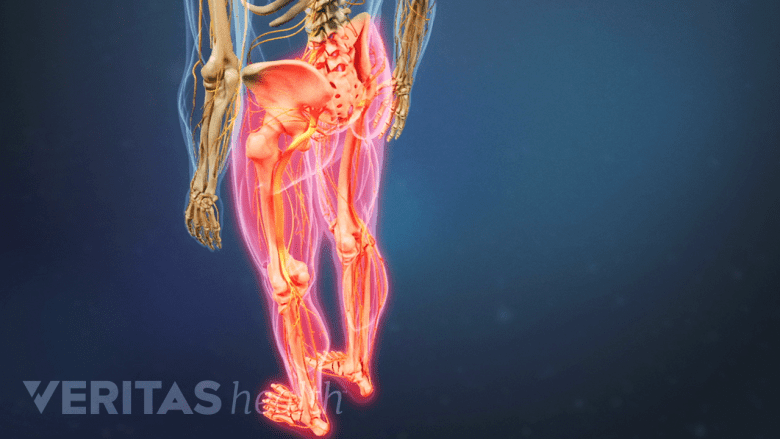While uncommon, it is possible that sciatica signs and symptoms may be a red flag for a number of serious conditions that may require immediate medical or surgical intervention.
Understanding and differentiating between benign sciatica symptoms and a medical emergency can help prevent disability and life-threatening consequences by seeking medical attention.
In This Article:
- When Sciatica Pain Is a Medical Emergency
- Spinal Cord Conditions with Sciatica Symptoms
- Spinal Tumors and Sciatica Symptoms
- Blood Vessel Conditions Causing Sciatica Symptoms
- Sciatica Causes and Symptoms Video
Serious Medical Conditions that May Cause Sciatica-Like Symptoms
Conditions with sciatica-like signs and symptoms that require prompt medical or surgical treatment include:
- Spinal cord compression or infection. Compression of the lumbar spinal cord or the cauda equina (nerves that descend from the spinal cord) can cause leg pain and back pain. Spinal cord abscesses, facet joint cysts, or infections can also cause back and leg pain, especially with movement.
Compression of the cauda equina nerves causes cauda equina syndrome, which warrants urgent medical attention. -
Tumors. Tumors of the lumbar epidural sheath (outer covering), bone, soft-tissues, sciatic nerve sheath, or the prostate gland may cause back pain and leg pain. Metastatic tumors (commonly from prostate cancer and lung cancer) may also cause symptoms mimicking those of spinal stenosis.
- Blood vessel problems. Blood vessel aneurysms, compartment syndrome, and blood vessel infections may cause leg and back pain similar to sciatica. These conditions may lead to loss of blood supply to the affected leg (ischemia) causing severe symptoms.
- Kidney problems. Kidney pain due to cysts, stones, or infections can radiate to the back and the legs.
-
Any type of nerve compression warrants prompt medical attention. If progressive leg weakness or numbness is present, the nerve may be damaged, potentially leading to loss of leg function. If the nerve is compressed and the pain and symptoms are severe, surgery may be required.
Red-flag Symptoms and Signs of Back Pain and Leg Pain
Weakness and numbness in both legs requires immediate medical attention.
It is advised to see a doctor when one or more of the following red-flag symptoms are present in addition to the sciatica pain:
- Severe pain in the back, leg, abdomen, and/or side of the body that may be felt:
- At rest
- At night
- While lying down, walking, bending at the hip, and/or pressing the low back
- Swelling in any part of the lower back, thigh, and/or leg
- A pulsating feeling in the leg or thigh
- Severe weakness or loss of sensation in the groin, legs, and/or genital area
- Fever, chills, and/or night sweats
- An itchy feeling in the painful regions of the leg that provokes the urge to scratch (pruritus)
- A cold feeling in the feet or toes
- Change in color of the skin over the legs or feet (commonly blue in cases of vascular insufficiency)
- A leg infection that does not heal
- Partial or total loss of bladder and/or bowel control, difficulty in passing urine or having a bowel movement, or blood in the urine or stool
- Sexual dysfunction
- Loss of appetite and/or weight
- Changes in the appearance of the skin, hair, and muscle mass in the extremities (hands and/or feet)
If sciatica pain develops as a result of a direct injury to the back, becomes severe or intolerable, and/or is not relieved with rest, self-care techniques, and/or exercise, it must be evaluated by a medical professional.
See Sciatica Surgery
A number of conditions that cause or mimic sciatica have the potential to cause loss of function in the leg(s) or lower back organs, and some may develop into life-threatening conditions. A history of cancer, diabetes, hypertension, or other systemic conditions may increase the risk of developing these problems.






